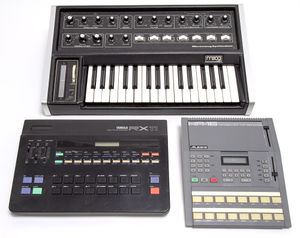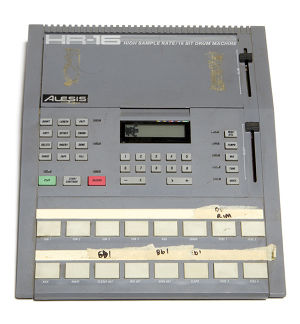Drum Machine
From This Might Be A Wiki
The drum machine has been an integral part of recording for They Might Be Giants from the earliest days of the band, particularly on their first four albums, until they adopted a live band for studio recording. John and John still use drum machines and programmed rhythm tracks for demos, some of which occasionally make it into final studio recordings.
Drum Machines and Instruments Used for Percussion
- Shure SM57 - For early, pre-drum machine recordings, a microphone was used to create a kick sound by thumping a thumb onto it and recording the sound.[1]
- Moog Micromoog - Also for early, pre-drum machine recordings, snare sounds were created by Flansburgh by using the white noise generator with a quick attack and slow decay. Examples of this snare sound can be heard on "Bread Hair", "I Need Some Lovin'"[2], "The Next Plane To London"[3], and the first demo of "Hell Hotel."
- Boss DR-110 Dr. Rhythm - The band's earliest drum machine used in recordings as far back as the first Dial-A-Song recordings in 1984[4]. Its sounds, particularly the hand claps, can be heard on "1999", the first demo of "Don't Let's Start" and songs on the 1984 Promotional Demo Tape. Flansburgh spoke of the instrument in Magnet Magazine in 2009:[5]
They came for the kick drum, but they stayed for the hand claps! The DR-110 was an early tool for TMBG. There is nothing real about the sounds that came out of this early “pro-sumer” drum machine, but more singular to the DR-110, there was nothing particularly big sounding about it, either. The graphic display can be tapped into, which put it well past the pre-programmed “accompanist” rhythm boxes that were created for console organ players, and hearing the results of an entirely hypothetical graphical idea turned into a rhythm wasn’t usually successful but was still fascinating.
- Oberheim DMX - Borrowed from Chris Butler of the Waitresses for a "fervered weekend" in 1984[6]. Can be heard on the Wiggle Diskette.
- Yamaha RX-15 - The RX-15 is a cut-down version of the RX-11 containing 15 sounds, and was first purchased by John Flansburgh from a "grey market" on Canal Street between Fall and Winter 1984[7]. One of the first tracks recorded with the drum machine was "Counterfeit Fake"[8].
- Yamaha RX-11 - The extra 14 sounds in the RX-11 (2 bass drum, 6 snares, and 1 additional rimshot, hi-hat set, tom, handclap, and cowbell), can be heard on many recordings from 1986 to early 1988. It was initially the drum machine used for Lincoln before the band was recommended the Alesis HR-16, and was also present on recordings from the Don't Let's Start EP such as "We're The Replacements". It is likely they used an RX-11 owned by Al Houghton's Dubway Studio.
- Alesis HR-16 - Purchased for Lincoln on the recommendation of Chris Butler who "had either witnessed a demo of or caught word that the new Alesis HR-16 was awesome."[9]
- Alesis HR-16-B - A later model of the HR-16 with expanded and different sounds. Owned by Flansburgh, but its use in recordings has not been mentioned or identified.[10]
- Alesis SR-16 - Only known to have been used on Flood[11] with drum programming by Alan Bezozi and John Flansburgh.
- Casio FZ-1 - A keyboard-based sampler used on Flood, Apollo 18 and beyond. For writing and recording Flood, both Linnell and Flansburgh each bought their own Casio FZ-1 samplers to use[12], working with Alan Bezozi[13] for the drum programming for various recordings on the album.
- Roland R8 - A sample-based machine, first used in 1989 on "Lady Is A Tramp" and "Birds Fly" from the scrapped Purple Toupee EP. Heavily featured on Flood and Apollo 18, and occasionally used after.[14] Flansburgh described it in 2018: "[The R8] was kind of the last of the big drum machine libraries. [...] The sound was much crisper while still often realistic."[15]
- Yamaha MU-5 - A small General MIDI tone generator with a button keyboard. The percussion sounds were used on "Your Own Worst Enemy" and, along with other instrument sounds, on John Linnell's House of Mayors EP.

